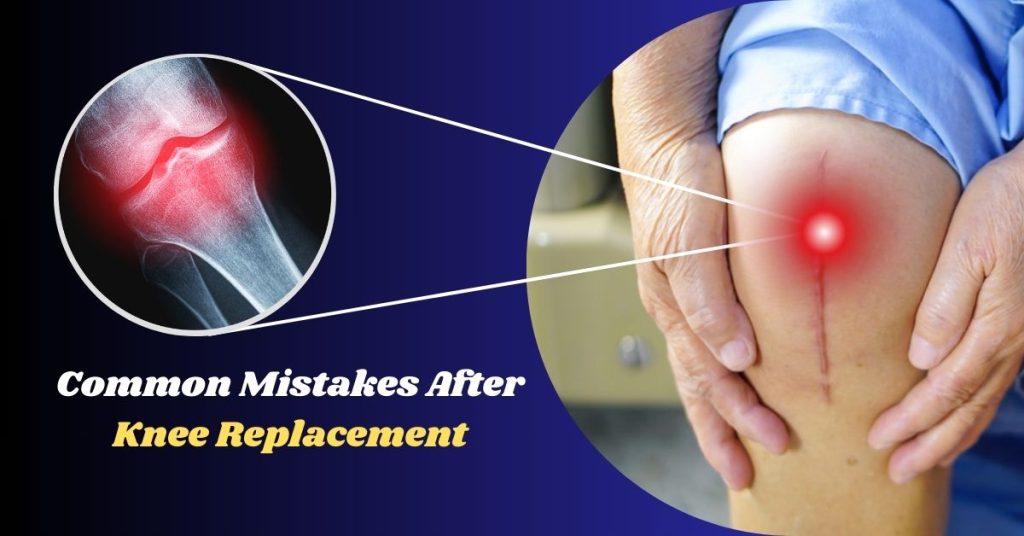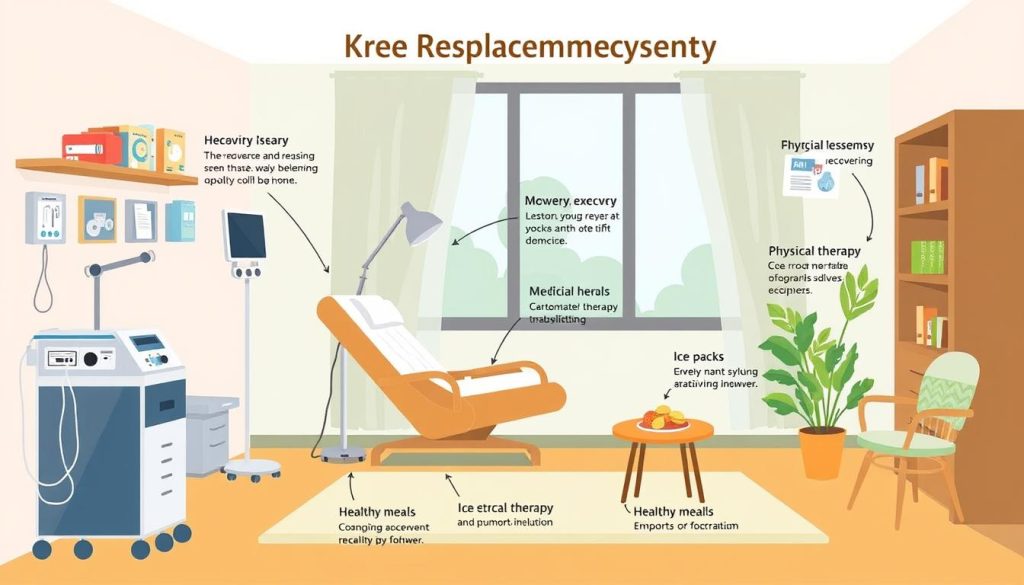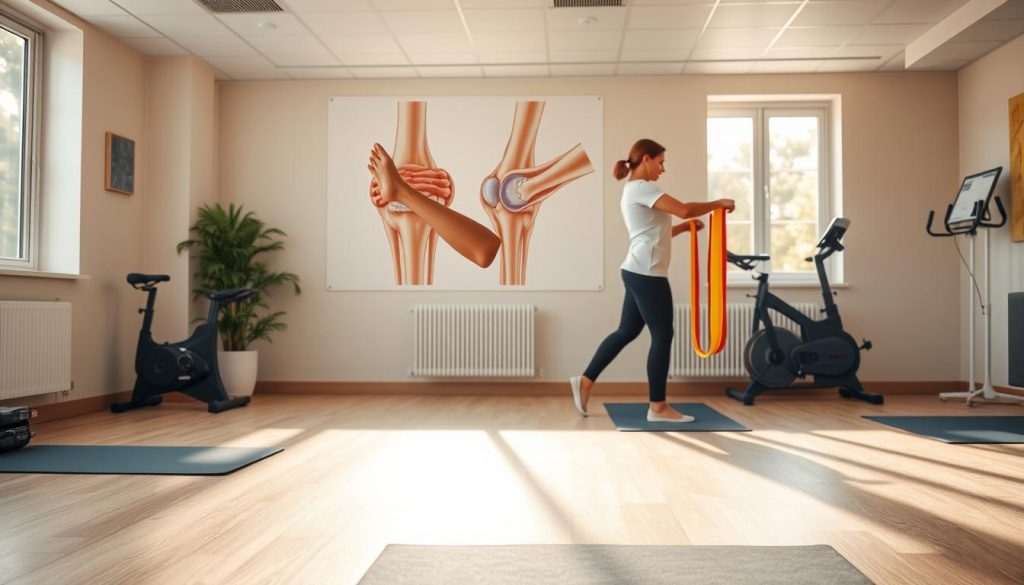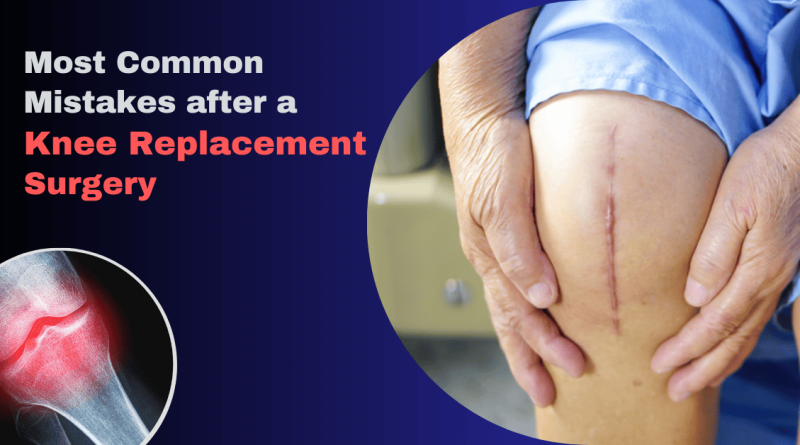Top 5 Mistakes After Knee Replacement and How to Avoid Them

The top 5 mistakes After Knee Replacement you are unknowingly doing and hurting your knee replacement recovery? Many patients make big mistakes that can slow down their healing and affect their mobility after surgery.
Recovering from a knee replacement is a careful journey. This way, you can get the best results possible.
This guide will show you the common mistakes people make after knee surgery. We’ll also share expert tips for a smooth recovery. You’ll learn about physical therapy and pain management, among other important topics.
Key Takeaways
- Recognize critical recovery mistakes that can hinder healing
- Learn proven strategies to optimize knee replacement rehabilitation
- Understand the importance of following medical guidance
- Identify possible risks during the recovery process
- Develop a proactive approach to post-surgical care
Understanding Knee Replacement Surgery Basics
Knee replacement surgery is a big step for those with severe joint pain and mobility issues. It’s key to know the basics to avoid mistakes and smooth out the recovery process. Before getting knee replacement surgery, it’s important to understand its complexity. The goal is to fix joint problems, reduce pain, and improve life quality for those with severe knee damage.
Types of Knee Replacement Procedures
Orthopedic surgeons usually suggest two main types of knee replacement:
- Total Knee Replacement (TKR): Replaces the whole knee joint
- Partial Knee Replacement: Fixes only the damaged parts of the knee
What to Expect During Recovery
Recovering from knee replacement surgery takes time and careful rehabilitation. You can expect:
- A hospital stay of 1-3 days
- Slowly getting back on your feet
- A detailed physical therapy plan
Important Pre-Surgery Preparations
Good preparation is key for a successful knee replacement. Here are some steps to take:
| Preparation Area | Recommended Actions |
|---|---|
| Physical Conditioning | Work on strengthening the muscles around your knee |
| Home Modification | Make your home safer by adding handrails and removing tripping hazards |
| Medical Evaluation | Get a full health check before surgery |
“Proper preparation can significantly reduce knee surgery recovery pitfalls and enhance surgical outcomes.” – Orthopedic Specialists Network
Knowing the basics of knee replacement surgery helps patients prepare better. It helps avoid complications and sets realistic recovery goals.
Common Complications Following Knee Surgery
Knee replacement surgery can change your life, but it comes with risks. Knowing these risks is key to avoiding mistakes during recovery.
Those going through knee replacement rehab should watch out for several big complications:
- Infection risks
- Blood clot formation
- Implant mechanical issues
- Nerve damage
- Unexpected mobility challenges
Surgical complications can greatly affect your recovery. Knowing about these issues helps you make better choices and stay on track with your healing.
| Complication Type | Warning Signs | Recommended Action |
|---|---|---|
| Surgical Site Infection | Redness, swelling, increased pain | Immediate medical consultation |
| Deep Vein Thrombosis | Leg swelling, warmth, tenderness | Urgent medical evaluation |
| Implant Misalignment | Persistent joint instability | Orthopedic specialist assessment |
“Knowledge is the best defense against knee replacement rehabilitation mistakes” – Orthopedic Specialists
By watching closely, following doctor’s orders, and talking openly with your healthcare team, you can avoid many mistakes. Stay alert and quick to report any odd symptoms during your recovery.
Read More- Lower Back Pain? 7 Immediate Ways to Fix It Today
Top 5 Mistakes After Knee Replacement
Knee replacement surgery starts a critical recovery journey. Patients often make mistakes that can harm their healing. Knowing these errors can help improve your recovery and rehabilitation.
Recovering from knee replacement surgery needs careful attention. Let’s look at the most common mistakes patients face:
Rushing the Recovery Process
Many patients don’t give their bodies enough time to heal. Pushing too hard too quickly can cause setbacks. Recovery needs patience, following your surgeon’s advice, and understanding it takes time.
- Patience with your body’s healing timeline
- Following your surgeon’s specific recovery guidelines
- Understanding that progress takes time
Skipping Physical Therapy Sessions
Physical therapy is key to successful recovery. Missing sessions can lead to:
- Reduced joint mobility
- Decreased strength in surrounding muscles
- Potential long-term movement limitations
Ignoring Pain Management Guidelines
“Pain management is not about eliminating all discomfort, but about creating a balanced approach to healing.” – Orthopedic Recovery Specialists
Good pain management means:
- Taking prescribed medications as directed
- Communicating with healthcare providers about pain levels
- Using recommended pain relief techniques
Poor Wound Care Practices
Preventing infection is vital during recovery. Proper wound care includes:
- Keeping the surgical site clean and dry
- Following specific cleaning instructions
- Watching for signs of infection
Neglecting Exercise Routines
Regular, gentle exercises are essential for recovery. Patients should:
- Perform recommended rehabilitation exercises
- Gradually increase activity levels
- Maintain a consistent workout routine
Avoiding these mistakes can greatly improve your recovery. Remember, every recovery is different, and personalized medical advice is key.
Essential Post-Surgery Care Guidelines
Recovering from knee replacement surgery needs careful attention to certain care guidelines. Patients need to know the key dos and don’ts. This ensures they heal well and avoid complications.

Post-surgery care includes several key steps that greatly affect your recovery. Following the right knee replacement recovery guidelines is essential for successful rehabilitation.
- Manage pain effectively with prescribed medications
- Use recommended assistive devices correctly
- Follow precise wound care instructions
- Gradually increase physical activity
- Attend all scheduled follow-up appointments
“Successful recovery is about patience and following professional medical advice precisely.” – Orthopedic Rehabilitation Specialist
Understanding the detailed approach to recovery helps patients avoid risks and heal better. Doctors suggest a structured plan for post-surgical care.
| Recovery Phase | Key Actions | Duration |
|---|---|---|
| Immediate Post-Surgery | Rest, pain management, light movement | First 1-2 weeks |
| Early Rehabilitation | Physical therapy, walking with assistance | 2-6 weeks |
| Advanced Recovery | Increased independent mobility, strength training | 6-12 weeks |
Following recovery guidelines closely can greatly improve long-term surgical results and joint function.
Creating an Optimal Recovery Environment at Home
Getting your home ready for knee replacement recovery is key to a smooth healing process. The right setup can greatly affect your recovery and rehabilitation journey.
To start your recovery right, make your living space supportive and easy to move around. You’ll need to make some changes to avoid risks and help your body heal.
Necessary Home Modifications
- Remove loose rugs and possible tripping spots
- Put in handrails in hallways and bathrooms
- Make paths clear for easy walker or wheelchair use
- Move furniture to make walking areas wider
Essential Recovery Equipment
| Equipment | Purpose |
|---|---|
| Raised toilet seat | Reduces strain during bathroom use |
| Shower chair | Provides safety and stability during bathing |
| Cold therapy unit | Manages pain and reduces inflammation |
| Grabber/reacher | Helps get items without too much movement |
Support System Setup
Building a strong support network is essential for recovery. Talk to family or think about hiring caregivers for help with daily tasks and emotional support.
“A well-prepared home environment can make the difference between a challenging recovery and a smooth rehabilitation process.” – Orthopedic Rehabilitation Specialist
Your home should be a place of healing. It should support your recovery, reduce risks, and help you regain mobility with confidence.
Read More-Navigating Health Challenges Beyond 50
Physical Therapy and Exercise Protocols

Physical therapy is key in knee replacement recovery. Knowing the right steps can greatly help your healing and joint function.
“Proper rehabilitation is not just recommended—it’s essential for successful knee replacement outcomes.” – Orthopedic Rehabilitation Specialists
Rehabilitation after knee replacement needs patience and planning. Staying away from common mistakes can make your recovery smoother.
- The initial recovery phase focuses on gentle range-of-motion exercises
- Gradual progression of strength training activities
- Consistent engagement with professional physical therapists
- Personalized exercise protocols based on individual healing rates
Here’s a look at typical exercises during knee replacement recovery:
| Recovery Phase | Exercise Focus | Duration |
|---|---|---|
| Week 1-2 | Ankle pumps, leg slides, gentle stretching | 15-20 minutes daily |
| Week 3-4 | Walking, stationary cycling, leg strengthening | 30-45 minutes daily |
| Week 5-8 | Advanced strength training, balance exercises | 45-60 minutes daily |
Key mistakes to avoid during knee replacement rehabilitation include pushing too hard too quickly, skipping recommended exercises, and neglecting professional guidance.
Working with a physical therapist is important. They help you follow safe, effective recovery plans tailored to your needs and progress.
Pain Management Strategies and Best Practices
Managing pain after knee replacement surgery is key to a good recovery. Many patients face errors that can slow down their healing. Knowing how to manage pain can help avoid these issues and make recovery smoother.
Medication Management Tips
It’s important to manage your medications right to control pain. Your doctor will give you a pain plan that fits your needs.
- Follow the exact dosage your doctor tells you
- Stick to a regular schedule for taking your meds
- Keep track of how much pain you have and how well the meds work
- Don’t change your medication without talking to your doctor first
Alternative Pain Relief Methods
There are ways to ease pain that don’t involve medicine:
- Cold therapy: Use ice packs to lower swelling
- Keep your leg that had surgery elevated gently
- Use compression methods suggested by physical therapists
- Try relaxation and deep breathing exercises
When to Contact Your Doctor
“Knowing the difference between normal pain and serious issues is vital for your safety.” – Orthopedic Rehabilitation Specialists
Watch out for signs that mean you need to see your doctor right away:
- Severe, hard-to-handle pain
- Big swelling or redness
- Signs of infection
- Fever over 101°F
- Pain that suddenly gets a lot worse
Actively managing your pain and talking openly with your healthcare team can greatly improve your recovery. It can also help avoid many common problems after surgery.
Monitoring Progress and Recovery Milestones
Tracking your knee replacement recovery needs patience and careful watching. Patients should have realistic hopes about their progress. Knee replacement recovery tips say to break your healing into easy-to-manage steps.
“Recovery is not a race, but a personal journey of healing and strength.” – Orthopedic Rehabilitation Specialist
Important recovery milestones include:
- Starting to move within 24-48 hours after surgery
- Walking with help within 1-2 weeks
- Slowly reducing pain meds
- Getting better at moving your knee
- Doing light daily tasks again
Following knee replacement dos and don’ts means watching your physical gains. Keep a recovery journal to track:
- Your pain levels each day
- How well you can move
- What you achieve in exercises
- How your physical therapy is going
Getting advice from your doctor is key during recovery. Regular visits with your orthopedic surgeon check your progress and catch any issues early.
Knowing your own recovery time helps avoid getting frustrated. Every person’s recovery is different. So, focus on your progress, not others.
Long-term Recovery and Lifestyle Adjustments
Recovering from a knee replacement is more than just the first few months. It’s about keeping your new joint safe and moving well for years. To avoid mistakes, you need to take care of your health and lifestyle.
Maintaining Joint Health
Keeping your new knee safe is key. Here are some important steps:
- Keep a healthy weight to ease knee pressure
- Do low-impact exercises as your doctor suggests
- Stretch and condition your muscles gently
- Use aids like canes to avoid straining your knee
Activity Modifications
Don’t rush back to hard activities too soon. Here’s how to adjust:
- Try swimming or cycling instead of running
- Use tools and methods that are easier on your knee
- Do gentle strength training
- Pay attention to your body and don’t push too hard
Future Prevention Strategies
| Strategy | Implementation | Benefits |
|---|---|---|
| Regular Medical Check-ups | Biannual orthopedic consultations | Early detection of problems |
| Physical Therapy | Ongoing strength and flexibility training | Better joint function and mobility |
| Nutrition | Anti-inflammatory diet rich in omega-3 | Less joint inflammation |
“Your knee replacement is an investment in your future mobility. Treat it with care and respect.” – Orthopedic Rehabilitation Specialist
Long-term success after knee replacement depends on consistent care, mindful activity, and a commitment to overall joint health.
Signs of Successful Recovery vs. Warning Signs
Recovering from knee replacement surgery needs careful attention to your body’s signals. By following knee replacement recovery guidelines, you can tell if you’re healing well or if there’s a problem. Knowing the signs of recovery is key.
- Gradual reduction in pain levels
- Increasing range of motion
- Improved walking stability
- Reduced swelling around the surgical site
- Ability to perform prescribed physical therapy exercises
When getting advice on post-surgery knee replacement, watch out for warning signs. These signs might mean you have a serious issue:
- Persistent high fever (above 101°F)
- Excessive redness or warmth around the surgical area
- Sudden increases in pain or swelling
- Drainage or unusual discharge from the wound
- Significant changes in leg mobility or sensation
“Early detection of complications can significantly improve recovery outcomes” – Orthopedic Specialists Network
Keeping a daily journal of your recovery can help you talk better with your doctors. If you notice anything odd, see a doctor right away. This can stop serious problems later on.
Knowing how to read your recovery signs helps you play a big part in your healing. This makes your recovery after knee replacement surgery smoother.
Conclusion
Recovering from knee replacement surgery needs careful attention and planning. Knowing the top 5 mistakes after knee replacement is key for patients. This helps them heal well and keep their joints healthy for a long time.
Every patient’s recovery is different. However, avoiding common mistakes can greatly improve how well they do after surgery.
The secret to good rehabilitation is being proactive with your doctors and sticking to physical therapy. It’s also important to follow your care plan closely. Patients who do this usually have an easier time recovering and get better results.
Common mistakes often come from being too impatient or not understanding the recovery process well. By staying informed and talking openly with your healthcare team, you can avoid problems. Also, doing rehabilitation exercises regularly helps you heal faster.
Remember, slow and steady progress is better than trying to rush your recovery. It’s more lasting.
Your journey with knee replacement is a big process that goes beyond the surgery. Enjoy each step of your recovery, listen to your body, and focus on keeping your joints healthy for the long haul. With the right care, commitment, and advice from experts, you can overcome the challenges of knee replacement. You’ll get your mobility and quality of life back.
FAQ
How long does knee replacement recovery typically take?
Recovery time for knee replacement surgery varies. It usually takes 3-6 months for basic recovery. Most people can get back to normal activities in 10-12 weeks.
But, it can take up to a year to reach full recovery and strength. Following your doctor’s advice, going to physical therapy, and exercising regularly are key.
What are the most common mistakes after knee replacement surgery?
Common mistakes include rushing the recovery and skipping physical therapy. Ignoring pain management and not taking care of wounds are also mistakes. Not sticking to an exercise routine is another error.
People often try to do too much too soon. Or they get discouraged and don’t follow their rehabilitation plan.
When can I drive after knee replacement surgery?
You can start driving 4-6 weeks after surgery. This depends on how well you’re recovering and if you can react quickly while driving. Always check with your surgeon first.
Make sure you can: – Stop quickly without trouble – Move your knee freely – Are not on strong pain meds – Feel confident and pain-free while driving
How can I manage pain during knee replacement recovery?
To manage pain, take your pain meds as directed. Use ice to reduce swelling. Do gentle exercises as your physical therapist suggests.
Use over-the-counter anti-inflammatory meds with your doctor’s okay. Elevate your leg and try relaxation techniques.
What modifications should I make to my home before surgery?
Make your home safe by installing grab bars in the bathroom. Remove tripping hazards like loose rugs. Set up a recovery station with essentials nearby.
Use raised toilet seats and arrange furniture for easy walking. Prepare a comfortable recovery area with easy access to what you need.
How important is physical therapy after knee replacement?
Physical therapy is very important for a good recovery. It helps restore your range of motion and builds muscle strength. It also improves joint flexibility and prevents scar tissue.
It reduces recovery time and lowers the risk of complications. Most people need 2-3 months of physical therapy for the best results.
What activities should I avoid after knee replacement?
Avoid high-impact sports like basketball or tennis. Don’t jump or run. Avoid heavy lifting and twisting movements.
Stay away from activities that require sudden changes in direction. Stick to low-impact exercises like swimming, walking, and stationary cycling as recommended by your healthcare professional.
When should I contact my doctor during recovery?
Call your doctor right away if you have: – A fever over 101°F – Increased redness or swelling – Pain that doesn’t go away with medication – Drainage from the surgical site – Signs of blood clots – Can’t bear weight – Severe stiffness or decreased mobility.
Read More:

